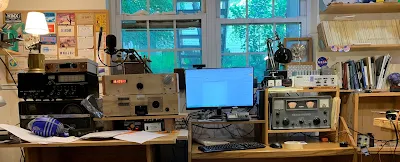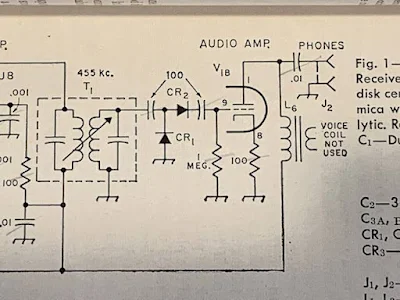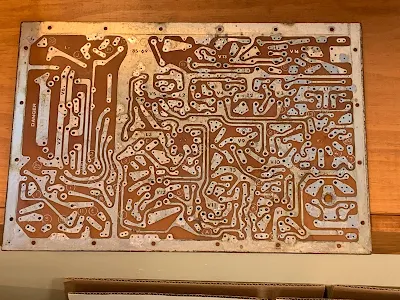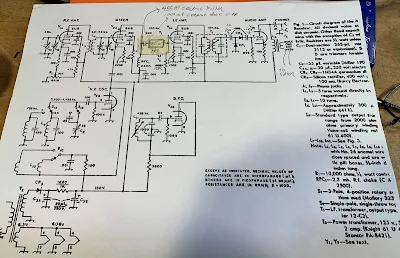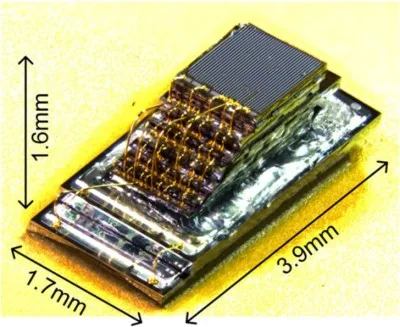Podcasting since 2005! Listen to Latest SolderSmoke
Tuesday, February 4, 2025
Mr. Carlson Restores a BC-348 -- But 40 Meters Sounds Very Weak. Why?
Wednesday, December 11, 2024
Mike WU2D's Video on the SimpleX Super Receiver -- Part II
Another FB video from Mike WU2D.
But you know, I too find myself kind of opposed to front panel on-off switches. I power my rigs with small DC supplies. I just turn on the supply when I want to use one of the rigs. I don't have or need a switch on the front panel of the rig.
I especially liked Mike's use of the gate dip meter and, of course, the Q meter. FB OM.
Monday, March 11, 2024
Radio Items Picked-up at VWS Winterfest 2024 Hamfest
-- Behind the MXM there is a nice box marked "Diode Detector" I opened it up and there is just a solid state diode and a 50 ohm resistor to ground. Box may be useful.
-- I got a couple of books: "Weekend Projects" 1979 from ARRL, and "A History of QST -- Volume 1 Amateur Radio Technology 1915 - 2013" 2013 from ARRL.
-- On top of the Weekend Projects book you see a "Crystal Holder" from Gross Radio of New York City. W1UJR has some good history on this company: https://w1ujr.com/written-word/gross-radio-company-circa-1931/ This device seem to be intended to hold in place a raw piece of quartz! Cool.
-- To the right of the books there is a serious-looking VFO. One dollar! Deal! It is a CB VFO, but the markings say it puts out 5.44 to 5.99 MHz. So it should be useful. The dual speed dial is very nice.
-- Above the VFO is a nice step attenuator from the "Arrow Antenna" company of Loveland Colorado.
-- Further to the right are some Electric Radio and Antique Wireless Association magazines that Armand WA1UQO gave me. Really nice. The AWA mags have a very thoughtful piece (warts and all) on Jean Shepherd. And the ER pile has an article by Scott WA9WFA that mentions my work on the Mate for the Mighty Midget receiver. Thanks again Armand!
-- I also got some ADE6+ surface mount mixers. The price was right!
Thanks to VWS for putting on this great hamfest!
Saturday, February 17, 2024
Nate KA1MUQ's Amazing Thermatron Receiver
Wow, some really wonderful work is taking place in Nate KA1MUQ's basement in California.
-- I really like the pill bottle coil forms. I wonder if Nate faced suspicion (and possible arrest) in the pharmacy when he asked for the pill bottles. (I got some suspicious looks when I went I asked for empty pill bottles while building my thermatron Mate for the Mighty Midget receiver back in 1998.)
-- The variable capacitors are also quite cool, as is the big rotary switch. Is that for band switching?
-- Oh man, all on a plywood board. Frank Jones would approve!
-- Indeed Nate, that beautiful receiver NEEDS an analog VFO. And we need to hear it inhaling phone sigs, not that FT8 stuff.
-- Please keep us posted on your progress. And of course, one hand behind your back OM. Lots of high voltage on those thermatrons.
Thanks Nate!
Friday, June 17, 2022
SolderSmoke Podcast #238 -- SolderSmoke Shack South, Cycle 25, Chiquita Banana Radio, RCA, HQ-100, Mate Mighty Midget, Sony SWL RX , Mailbag
SolderSmoke Podcast #238 is available: http://soldersmoke.com/soldersmoke238.mp3
TRAVELOGUE:
Cathartic decluttering: Bill preparing for future winter travel to Dominican Republic. Will build SolderSmoke Shack South. Dividing everything up: Rigs, parts, tools, supplies, antennas, test gear. Everything.
PETE'S BENCH:
Saturday, June 11, 2022
Putting the "Mate for the Mighty Midget" Back to Work -- With a DX-100 on 40 Meter AM
After working on it for a while I got so fond of my old Hammarlund HQ-100 that I moved it from the AM/Boatanchors operating position over to a more convenient spot right next to my computer. This left a big gap on the receive side of the AM station.
I briefly put my HRO-ish solid state receiver above the DX-100, but I'm afraid that receiver needs some work. More on that in due course.
I thought about putting my SOLID STATE Lafayette HA-600A atop the thermatronic DX-100, but this just didn't seem right. The Radio Gods would NOT approve.
So I turned my attention to the Mate for the Mighty Midget that I built in 1998 and have been poking at and "improving" ever since.
This receiver worked, but not quite right. It received SSB stations well enough, but when I turned off the BFO I could no longer hear the band noise. I wasn't sure how well the RF amp's grid and plate tuned circuits tracked. And I had serious doubts about the detector circuit that Lew McCoy put in there when he designed this thing back in 1966.
As I started this latest round of MMMRX poking, I realized that I now have test gear that I didn't have in 1998: I now have a decent oscilloscope. I have an HP-8640B signal generator (thanks Steve Silverman and Dave Bamford). I have an AADE LC meter. And I've learned a lot about building rigs.
FRONT END TRACKING
The MMRX has a tuned circuit in the grid of the RF amplifier, and another in the plate circuit of the RF amplifier. There is a ganged capacitor that tunes them both. They need to cover both 80/75 and 40 meters. And they need to "track" fairly well: over the fairly broad range of 3.5 to 7.3 MHz they both need to be resonant at the same frequency.
McCoy's article just called for "ten turns on a pill bottle" for the coils in these parallel LC circuits. The link coils were 5 turns. No data on inductance was given. Armed now with an LC meter, I pulled these coils off the chassis and measured the inductances of the coils. I just needed to make sure they were close in value. They were:
L1 was .858uH L2 was 2.709 L3 was .930uH L4 was 2.672
Next I checked the ganged variable capacitors. At first I found that one cap had a lot more capacitance than they other. How could that be? Then I remembered that I had installed trimmer caps across each of the ganged capacitors. Adjusting these trimmers (and leaving the caps connected to the grid of V1a and V2A, I adjusted the trimmers to get the caps close in value. I think I ended up with them fairly close:
C1: 63.77-532 pF C2 64.81 -- 525.1 pF
I put the coils back in and checked the tracking on 40 and on 80/75. While not perfect, it was close enough to stop messing with it.
DETECTOR CIRCUIT
I've had my doubts about the detector circuit that Lew McCoy had in the MMMRX. In his 1966 QST article he claimed that the circuit he used was a voltage doubler, and that this would boost signal strength. But I built the thing in LT Spice and didn't notice any doubling. And consider the capacitors he had at the input and output of the detector: 100 pF. At 455 kHz 100 pF is about 3500 ohms. At audio (1 kHz) it is 1.5 MILLION ohms. Ouch. No wonder years ago I put a .1 uF cap across that output cap just to get the receiver working.
Scott WA9WFA told me that by the time the MMMRX appeared in the 1969 ARRL handbook, the second "voltage doubling" diode was gone, as were the 100 pF caps. Now it was just a diode, a .01 uF cap and a 470,000 ohm resistor. I switched to the 1969 Handbook circuit (but I have not yet changed the 1 meg grid resister to 470k -- I don't think this will make much difference). Foiled again by a faulty QST article, again by one of the League's luminaries.
6U8s out, 6EA8s in
We learned that the 6U8 tubes originally called for by Lew McCoy are getting old and not aging well. So I switched all three to more youthful 6EA8s. This seemed to perk the receiver up a bit.
MUTING from the DX-100
My K2ZA DX-100 has a T/R relay mounted in a box on the back of the transmitter. When the Plate switch goes up, it switches the antenna from receiver to transmitter. The box also has a one pole double throw switch available for receiver muting. I put the common connection to ground, the normally connected (receive position) connect the ground terminal of the AF output transformer to ground -- it is disconnected from ground on transmit. The other connection (normally open) is connected to the antenna jack -- on transmit this connection ground the receiver RF input connection. These two steps mutes the receiver very nicely.
Replacing Reduction Drive
Over the years I have had several different reduction drives on the main tuning cap. I had a kind of wonky Jackson brothers drive on there that needed to be replaced. I put in a new one -- this smoothed out he tuning considerably.
Ceramic Resonator
I never could get McCoy's 455 kc two crystal filter to work right. So at first I made due with the two 455 kc IF cans. This made for a very broad passband. Then I put a CM filter in there. This was more narrow, but with a lot of loss. There may have been others. But the filter spot is currently held by a 6 kHz wide ceramic filter. This one is my favorite so far.
Digital Readout
When I was running the DX-100 with the Hammarlund HQ-100 I built a little frequency readout box. The box was from a Heath QF-1 Q multiplier (I am sorry about this). The readouts are in Juliano Blue and come via e-bay from San Jian. I now have it hooked up to the DX-100's oscillator. I haven't tapped into the MMMRX's oscillator yet.
Tuesday, March 15, 2022
VK2BLQ's Two-Tube Regen with a SolderSmoke Dial
Monday, February 14, 2022
6EA8s in the Mate for the Mighty Midget, and WA9WFA Re-Builds a Heath HW-12
I reported to Scott and Grayson that I had finally gotten around to changing the three aging 6U8 tubes in my Mate for the Mighty Midget receiver. I replaced them with three more youthful 6EA8s. This switch really seemed to perk up the old receiver. I'm listening to 75 meters on it right now.
Speaking of 75 meters, Scott sent me this picture of his latest effort: re-building a Heathkit HW-12. FB. This is a way of experiencing (or re-experiencing) the construction of a Heathkit. I did something similar, but much less complicated) with a Heathkit VF-1. Scott did a wonderful job taking this old rig apart. That PC board looks great (see photo below).
Scott's e-mail:
Hi Bill and Grayson, I’m glad to hear of your good results with the 6EA8’s in your MMMrx! I had similar results when I finally got rid of the 6U8’s with their iffy performance and went with the 6EA8’s. I did put a set of 6GH8A’s and tried it out, it worked, but I don’t have any data on performance improvements. After completing the outboard power supply and audio amplifier, I’ve taken a break from my MMMRx and it’s sitting there on the bench. I’ll get back to it in a while.
In the meantime I’ve started a new project where I’m re-kitting a Heathkit HW-12 eighty meter transceiver. I have completed the disassembly process including the pcb. I bought a Hakko vacuum desoldering iron for taking all (ALL) parts off of the pcb, and it’s bare now. I’m planning to start rebuilding this coming week. 73 Scott WA9WFA
Saturday, December 4, 2021
A Great Morning on the Old Military Radio Net: AB9MQ's Central Electronics 20A, W3EMD's Dynamotor, WU2D
I usually try to listen in on the Old Military Radio Net on Saturday mornings (3885 kc). Lately I listen with my Mate for the Mighty Midget receiver.
This morning's session was especially good. For me the highlight was when Masa AB9MQ called in from Normal, Illinois using his Central Electronics 20A (see below). That was one of the earliest SSB rigs. A phasing rig, it also ran AM (which was what Masa was using this morning). He had it paired up with a Central Electronics 458 VFO. You folks really need to check out Masa's QRZ.com page:
Buzz W3EMD called in from Rhinebeck, NY. I could hear his dynamotor in the background. Buzz said hello to Masa in Japanese. FB.
Always great to hear Mike WU2D.
Sunday, November 21, 2021
KG7TR's Magnificent 75S-2B Receiver -- Tubes, an Si5351, an Arduino, a Bit of Collins, and a Bit of a Drake 2-B
I was led to this magnificent receiver by the very humble 6U8 tube. Scott WA9WFA and I have been learning (mostly from Grayson KJ7UM) that the much used and sometimes loved 6U8s (three of them in our "Mates for the Mighty Midget") might be a bit long in the tooth, old even by Thermatron standards. I was worried when I remembered that my Drake 2-B has a 6U8 in it -- V2, the first mixer. So I Googled for more info and was led to this amazing receiver, a 2018 creation by KG7TR. How did we NOT see this for almost four years?
Here is more info and pictures:
http://www.kg7tr.com/75s-2b-receiver.html
Here is Mike's write-up of the project:
Mike KG7TR's web site:
As for the 6U8s, well Grayson says the tube has been getting something of a bum rap. And KG7TR has two of them in this receiver, so I will obviously have to give the 6U8 another chance.
--------------------
I didn't know that Lew McCoy had his own crystal and crystal filter company:
Wednesday, November 17, 2021
SolderSmoke Podcast #234: PSSST, KWM-1, VHF Woes, Mighty Midget, TinySA, 17-12 Dual-Bander Advice Needed. MAILBAG
PSSST Super Simple SSB -- 7 Transistors. Switching IF Module:
DC RX.
KWM-1 Resurrection "Shame Shelf".
How to make things work:
Diode Switching or Relays?
National Receiver.
Bill's Bench
Farhan's Talk to RSGB got me thinking of VHF 2 meter AM.
2 meter Benton Harbor lunchbox madness. SuperRegens Super Strange.
I broke my Maplin AF Sig Gen in the process. Fixed it.
Playing with MMMRX again. Put in 6 kHz ceramic filter. Sounds great SSB and AM.
Swept IF with noise, TinySA, and NanoVNA. Need better noise gen.
Mod to listen with TinySA (on blog).
Thinking of 17 meter /12 meter Dual-Bander IF around 21.4, VFO around 3.41 Mhz. Thoughts?
Sweeping double half lattice filter from Swan 240. UGLY.
MAILBAG:
--- ROOTS OF MAILBAG: Radio Moscow, Havana Cuba, HCJB, others.
-- Thomas K4SWL of the SWL Post: Could have been worse! Stairbag?
-- Drew N7DA worked Wes W7ZOI in Sweepstakes. FB.
-- Peter VK2EMU The movie Frequency and the Magic of Heathkits. Good, but not that good!
-- Thomas KK6AHT! Our old friend. Minima! Now has a young son! FB
-- Chuck WA7ZZE Saw QST profile. Sympathizes with Two-er trouble.
-- Tim M0CZP. Spell corrector. Vatican Diodes. Infallible!
-- Ramakrishnan VU3RDD Working on a NORCAL and a noise cancellation arrangement.
-- Skip NC9O said I was 40 Hz off on 17. But he had a reason to KNOW!
-- Steve K9NVD Glad he's a listener.
-- Bob KY3R Novice Nostalgia. Should he use 75 watt bulb for dummy load? Yes!
-- Todd K7TFC Video about why solder smoke goes into the face.
-- Anthony VU3JVX Homebrew Antuino. I ask for help in moving freq to 450 kHz.
-- Jack NG2E Building Pete's DC RX.
-- Scott WA9WFA HBR-13 and MMMRX.
-- Stephen 2E0FXZ also got a FT-101 VFO.
-- Bob K7ZB on the air with 56 mW and a big antenna.
-- Dean AC9JQ Retired.
-- Allan WA9IRS Right to Repair update.
-- Farhan Invited us to Lamakaan ARC, Dec 11 or 12. Will be on QO100 Satellite Live!
Happy Thanksgiving to all who celebrate this holiday!
Friday, November 12, 2021
Mate for the Mighty Midget with 6 kHz Ceramic Filter
Monday, October 25, 2021
Putting a Ceramic Filter in the "Mate for the Mighty Midget" Receiver
Sunday, October 24, 2021
WA9WFA's Mate for the Mighty Midget 1966 QST Receiver

Wednesday, October 13, 2021
SolderSmoke Podcast #233: PIMP, Boatanchors, Novices, MMM, Heathkits, DC Receivers, Mailbag
SolderSmoke Podcast #233 is available.
http://soldersmoke.com/soldersmoke233.mp3
Travelogue: Cape Cod. SST. Marconi Site.
The WFSRA: The World Friendship Society of Radio Amateurs.
Pete's Bench:
The Pimp.
The NCX rig.
The Collins.
The many DC receivers built worldwide.
The parts shortages are real! Several key radios on hold. Si5351 sub.
Talk to G-QRP convention
Bill's Bench:
FT-8. Not for me. I tried it.
Novice Station Rebuild.
Globe V-10 VFO Deluxe.
Selenium rectifier removal CONTROVERSY?
Not crazy about my Novice station. Not crazy about CW.
Mate for the Mighty Midget. Again.
Mike W6MAB -- Detector problems LTSPICE Check
One more mod for MMM RX. Ceramic filter at 455.
Dropped screw inside tubular cap on Millen 61455 transformer.
Talk to the Vienna Wireless Society
Thinking of a Moxon or a Hex beam.
BOOK REVIEW Chuck Penson WA7ZZE New Heathkit Book. http://wa7zze.com
Mailbag
-- New SPRAT is out! Hooray!
-- Todd K7TFC sent me copy of Shopcraft as Soulcraft. FB.
-- Dean KK4DAS building an EI9GQ 16 W amp. FB.
-- Jack NG2E Getting close on Pete's DC receiver.
-- JF1OZL's website is BACK!
-- Tony K3DY sent link to cool books.
-- Sheldon VK2XZS thinking of building a phasing receiver.
-- Peter VK2EMU has joined the WFSRA. FB!
-- Ned KH7JJ from Honolulu spotted the Sideband Myth in the AWA video.
-- Chris M0LGX looking at the ET-2, asks about the variometer.
-- Pete Eaton Nov 64 anti HB rant in november 1964 QST. Wow.
-- Josh Lambert Hurley spreading FMLA stickers in the UK. FB
-- Stephen VE6STA getting ready to melt solder.
-- Got a great picture of Rogier PA1ZZ back on Bonaire.
-- Farhan reading the manual of Hans's new digital rig.
-- Paul G0OER wonders if FMLA getting ready to move on 5 meters.
Saturday, October 9, 2021
Recent Homebrew Projects from Jan PA3GSV (of "Mate for the Mighty Midget" Fame)
Recent talk of the Mate for the Mighty Midget receiver and Pete's PIMP SSB transmitter brought me back in contact with the work of Jan, PA3GSV. I took a look at his QRZ.com page and found that he has some projects that rival even his seemingly unbeatable MMM RX project.
Check it out for some real homebrew eye candy:
Thursday, October 7, 2021
Another M^3: The Michigan Micro Mote
Move over Michigan Mighty Mite and Mate for the Mighty Midget. There's a new M^3 in town. And it is SMALL.
Hack-A-Day had an article on this today, and while it seems only tenuously connected to ham radio, I found it intriguing.
Monday, October 4, 2021
Scott WA9WFA's Mate for the Mighty Midget Receiver is WORKING! (Video)
Sunday, August 22, 2021
Joe Galeski's 1960 "IMP" 3 -Tube Filter SSB Transmitter, and the Spirit of SSB Homebrew
Here is another important bit of SSB history. In May 1960, Joe Galeski W4IMP published an article in QST describing his super-simple SSB transmitter. While Tony Vitale's "Cheap and Easy" rig was a phasing design, Joe came up with a filter rig. He built USB filter at 5775 kc. With it, he ran a VXO at around 8525 kc. This put him on 20 meter USB.
Here is the QST article: http://marc.retronik.fr/AmateurRadio/SSB/A_3_tubes_filter_rig_%28SSB%29_%5BQST_1960_5p%5D.pdf
In discussing how to put this rig on other bands, Joe got the sideband inversion question exactly right:








